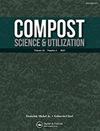Growth and Fruit Chemical Characteristics of Blackberry (Rubus Fruticosus) Cultivated with Vermicompost, Glomus Mosseae and Phosphate Rock
IF 0.9
4区 农林科学
Q3 ECOLOGY
引用次数: 5
Abstract
Abstract The aim of this investigation was to determine the effect of vermicompost (V) and phosphate rock (PR) on blackberry (Rubus fruticosus L. agg.) plants inoculated with Glomus mosseae (Nicol. & Gerd.) Gerdemann & Trappe (AMF). Plant growth parameters, total phenol compounds and total flavonoids were evaluated on leaves. Anthocyanin contents, soluble solids (SS), pH, titratable acidity (TA) and SS/TA ratio was evaluated in blackberries fruits. Blackberry plants were obtained from cuttings from field plants, which were distributed in soil according to a randomized complete block design with three repetitions. Treatments were vermicompost (10░g plant−1), phosphate rock (1░g plant−1), Glomus mosseae (AMF), (1░g plant−1), PR + AMF, V + PR, V +AMF, V + PR+ AMF and control without any amended. Plant height and stem diameter were measured five months after treatments, while total phenols and total flavonoids in leaves were evaluated eight months later. Anthocyanins, SS, pH, and TA were determined in blackberry fruits ten months after. Plant height was not statistically affected (p≤0.05), although total phenol compounds were higher (21.1░mg g−1 dry plant) in the V+PR+AMF treatment, whereas the V + AMF treatment produced more dry plant total flavonoids (1.4░mg g−1), compared with control plants. Blackberries produced with the vermicompost treatment had more anthocyanins (9.54░mg g−1) than control plants. Soluble solids, pH and titratable acidity were not statistically (p≤0.05) affected by any treatment.蚯蚓堆肥、苔藓球囊菌和磷矿栽培黑莓的生长和果实化学特性
摘要本研究的目的是确定蚯蚓堆肥(V)和磷矿石(PR)对接种Glomus mosseae(Nicol.&Gerd.)Gerdemann&Trappe(AMF)的黑莓(Rubus fruticosus L.agg.)植物的影响。对叶片的生长参数、总酚类化合物和总黄酮类化合物进行了评价。对黑莓果实中花青素含量、可溶性固形物(SS)、pH值、可滴定酸度(TA)和SS/TA比值进行了测定。黑莓植物是从田间植物的插条中获得的,这些插条根据三次重复的随机完全块设计分布在土壤中。处理为蚯蚓堆肥(10░g植物−1)、磷矿石(1░g植物−1),Glomus苔藓科(AMF),(1░g植物−1)、PR+AMF、V+PR、V+AMF、V+PR+AMF和对照,无任何修改。处理后5个月测量株高和茎粗,8个月后评估叶片中的总酚和总黄酮。10个月后测定了黑莓果实中的花青素、SS、pH和TA。株高没有受到统计学影响(p≤0.05),尽管总酚化合物更高(21.1░mg g−1干植物),而V+AMF处理产生更多的干植物总黄酮(1.4░mg g−1)。用蚯蚓堆肥处理生产的黑莓含有更多的花青素(9.54░mg g−1)。可溶性固形物、pH值和可滴定酸度不受任何处理的统计学影响(p≤0.05)。
本文章由计算机程序翻译,如有差异,请以英文原文为准。
求助全文
约1分钟内获得全文
求助全文
来源期刊

Compost Science & Utilization
农林科学-生态学
CiteScore
4.10
自引率
0.00%
发文量
0
审稿时长
>36 weeks
期刊介绍:
4 issues per year
Compost Science & Utilization is currently abstracted/indexed in: CABI Agriculture & Environment Abstracts, CSA Biotechnology and Environmental Engineering Abstracts, EBSCOhost Abstracts, Elsevier Compendex and GEOBASE Abstracts, PubMed, ProQuest Science Abstracts, and Thomson Reuters Biological Abstracts and Science Citation Index
 求助内容:
求助内容: 应助结果提醒方式:
应助结果提醒方式:


